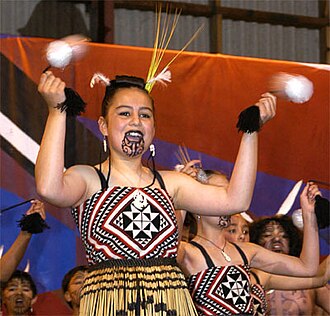Difference between revisions of "AY Honors/Māori Lore/Answer Key"
| (One intermediate revision by the same user not shown) | |||
| Line 1: | Line 1: | ||
[[Image:Poi-manutuke.jpg|thumb|Māori Poi dance, by Manutuke School at Hopuhopu 2003]] | [[Image:Poi-manutuke.jpg|thumb|Māori Poi dance, by Manutuke School at Hopuhopu 2003]] | ||
| − | '''Poi''' is a form of [[juggling]] | + | '''Poi''' is a form of [[juggling]] with balls on ropes, held in the hands and swung in various circular patterns, similar to [[Indian clubs|club-twirling]]. It was originally practiced by the [[Maori|Māori]] people of [[New Zealand]] (the word ''poi'' means "ball" in Māori). Women used it as an exercise to increase flexibility of the wrists and hands, and by men to increase strength in the arms and coordination. It developed into a traditional performance art practiced mostly by women. This art in conjunction with others like ''waiata a ringa'', [[haka]] and ''titi torea'' form the performance art of [[Kapa haka]]. |
Some say that originally it was less art and more utilitarian in that it was how the [[kai]] (food) was traditionally prepared: attaching the ball-like poi to rope and swinging it in circles to build momentum and then smashing on rocks or other hard surfaces. | Some say that originally it was less art and more utilitarian in that it was how the [[kai]] (food) was traditionally prepared: attaching the ball-like poi to rope and swinging it in circles to build momentum and then smashing on rocks or other hard surfaces. | ||
| − | Today, poi swinging is seeing wide popularity outside of Māori culture. Poi swingers use everything from rolled-up socks to expensive devices with light-emitting diodes and combine swinging with body moves. This is known as [[fire dancing|fire poi]] when the poi are made of wicks and set on fire | + | Today, poi swinging is seeing wide popularity outside of Māori culture. Poi swingers use everything from rolled-up socks to expensive devices with light-emitting diodes and combine swinging with body moves. This is known as [[fire dancing|fire poi]] when the poi are made of wicks and set on fire. |
== External links == | == External links == | ||
| Line 11: | Line 11: | ||
* [http://www.fire-dancing.com/fire-poi.php Fire Poi] World-wide fire poi trainers & performers. | * [http://www.fire-dancing.com/fire-poi.php Fire Poi] World-wide fire poi trainers & performers. | ||
* [http://www.poipoi.info/ PoiPoi] Online Poi Community with tips and tricks, videos and instruction. | * [http://www.poipoi.info/ PoiPoi] Online Poi Community with tips and tricks, videos and instruction. | ||
| − | *[http://www. | + | * [http://www.templeofpoi.com] Premier Poi school in the world; based in San Francisco, CA, USA; On line computer based training available for worldwide customers |
| − | |||
[[Category:New Zealand culture]] | [[Category:New Zealand culture]] | ||
[[Category:Juggling]] | [[Category:Juggling]] | ||
Revision as of 18:40, 18 October 2005
Poi is a form of juggling with balls on ropes, held in the hands and swung in various circular patterns, similar to club-twirling. It was originally practiced by the Māori people of New Zealand (the word poi means "ball" in Māori). Women used it as an exercise to increase flexibility of the wrists and hands, and by men to increase strength in the arms and coordination. It developed into a traditional performance art practiced mostly by women. This art in conjunction with others like waiata a ringa, haka and titi torea form the performance art of Kapa haka.
Some say that originally it was less art and more utilitarian in that it was how the kai (food) was traditionally prepared: attaching the ball-like poi to rope and swinging it in circles to build momentum and then smashing on rocks or other hard surfaces.
Today, poi swinging is seeing wide popularity outside of Māori culture. Poi swingers use everything from rolled-up socks to expensive devices with light-emitting diodes and combine swinging with body moves. This is known as fire poi when the poi are made of wicks and set on fire.
External links
- Home of Poi Comprehensive information about POI, staff and fire twirling, including animated lessons, discussion forums, building instructions, articles and a shop.
- Fire Poi World-wide fire poi trainers & performers.
- PoiPoi Online Poi Community with tips and tricks, videos and instruction.
- [1] Premier Poi school in the world; based in San Francisco, CA, USA; On line computer based training available for worldwide customers

